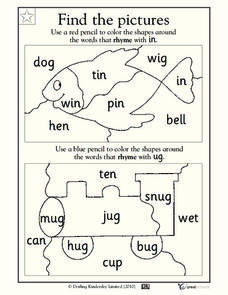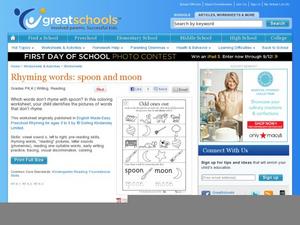Curated OER
Match the Letters
Build a foundation of alphabet familiarity using this matching worksheet. Learners focus on lowercase letters a, o, c, d, g, and q as they match balloons to corresponding children. Each balloon and child has a letter inside, so...
Curated OER
Match the Letters
Build familiarity with alphabet letters to ensure your pre-readers are set up for reading success. They examine six lowercase letters on leaves, drawing lines to connect them to trees with the same letter. They will develop awareness of...
Curated OER
Match the Letters
Before youngsters begin reading, they need a foundational familiarity with alphabet letters. This matching instructional activity focuses on lowercase letters m, n, u, v, and w. Learners match letters on teddy bears with the same letter...
Curated OER
Find the Letters
Help beginning readers recognize that whole words are made up of individual letters. They examine a set of lowercase letters and circle the ones they find in a CVC word. Learners do this for the words bin and cup.
Curated OER
Play I Spy: In the Bathroom
Usually playing I Spy in the bathroom causes trouble, but not in this instructional activity! Little readers look for objects that begin with the letters b and t. They circle the objects in the picture, count how many of each they found,...
Curated OER
Connect the Rhymes
Pre-readers benefit from visual context clues like the ones in this rhyme worksheet. There are two sets of objects here, and scholars connect objects on the left with their rhyming counterparts on the right. Each word has the vowel...
Curated OER
Play I Spy
Pre-readers examine a rainy-day picture with many details to find words beginning with either p, u, w, or l. They tally the number of objects they find and write the numbers beside each letter. To help kids stay organized and meet...
Curated OER
Letter Recognition: Letter Z
In this letter recognition instructional activity, students examine 2 groups of letters and identify the Z's. Students also trace and write uppercase Z and lowercase z independently.
Curated OER
Letter Recognition: Letter W
In this letter W recognition worksheet, students examine 2 groups of letters and identify uppercase and lowercase Ws in the groups. Students also trace and independently write the uppercase and lowercase letters.
Curated OER
Find the Rhyme
Which one rhymes? There are four starting objects here, each heading a row of three objects. Learners identify the objects and their vowel sounds to determine which one rhymes with the first object. All these rhyming words involve the...
Curated OER
Matching Directions
Which of these shapes is pointing the same way? Pre-readers examine five rows of familiar objects. The first item points to the right for each, and they must determine which of the subsequent items in each row points the same direction....
Curated OER
Letter Concepts Worksheet 1 - 5
In this letter identification instructional activity, students read 30 letters that begin a row of six letters then circle the letter in each row that matches the first letter in that row.
Achieve3000
Discriminating Phonemes
Develop the fluency of beginning readers one sound at a time with this phonemic awareness instructional activity. Through a series of whole-class instruction, independent practice, and collaborative learning activities,...
Curated OER
Connect the Rhymes
Introduce your pre-readers to rhyming using this matching exercise! They examine two sets of images, connecting rhyming pictures with a line. All 10 words use the vowel sound i. Note that some of these images may be difficult for...
Curated OER
Odd Ones Out
Some of these words don't rhyme; scholars determine which ones as they examine four sets of images with the vowel sound /e/. For each set, they circle the words that don't rhyme with the first image. Be sure kids know what these images...
Curated OER
Find the Rhyme
Which of these objects rhymes? There are four starter pictures here, each heading rows of three objects. Learners determine and circle the row object that rhymes with the first one. Then, they connect two of the CVC words with printing...
Curated OER
Odd One Out
Which word doesn't rhyme? As they practice vowel-sound recognition, scholars examine rows of familiar objects to determine which object doesn't rhyme. There are four rows here, each with a beginning image and three subsequent images....
Curated OER
Connect the Rhymes
As your pre-readers begin to understand phonemes and rhyming, give them this practice learning exercise which has them matching rhyming pictures. For each of six images, they identify the corresponding image which has the same vowel...
Curated OER
Connect the Rhymes
Connect these rhyming images. There are two sets of six familiar pictures here, and scholars draw a line from the left objects to their rhyming partners on the right. The images may be difficult for learners to identify, so be sure this...
Curated OER
Draw it Yourself
Here are four familiar pictures and words for emerging readers: dog, mouse, cat, and hen. After examining the image and spelling, they draw something that rhymes with each in the space provided. Encourage pre-readers to sound...
Curated OER
Draw it Yourself
What rhymes with fox? Get learners engaged with rhyming words through this drawing activity featuring four single-syllable words for beginning readers. For each, they draw something that rhymes with the word. Challenge learners who need...
Curated OER
Find the Pictures
Uncover the hidden pictures. There are two sets of shapes here, and each has a CVC word inside. Beginning readers follow directions by coloring all the shapes with words that rhyme with a given sound (in for the first and ug for the...
Curated OER
Rhyming Words: Spoon and Moon
One of these things is not like the other, one of these things does not belong. It's true! Little learners will say each of the four words in each of four rows, to determine which one does not rhyme with the others. After that, they...
Curated OER
Find the Rhyme
Find the rhyming word. All of these rhyming, single-syllable words have the short i sound, but learners have to determine which ones they are. There are four starting objects each heading a row of three objects. They examine the...























